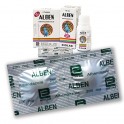 View full size
View full size
Alben / Albendazole 200 mg - Worms Treatment
Alben / Albendazole 200 mg - Worms Treatment
TYPICAL USAGE: Ascaris, hookworm, enterobius and trichuris. Tapeworms and strongyloidosis. Trichinosis. Neurocysticercosis. Cutaneous larva migrans. Hydatid disease. Filariasis.

























Follow us